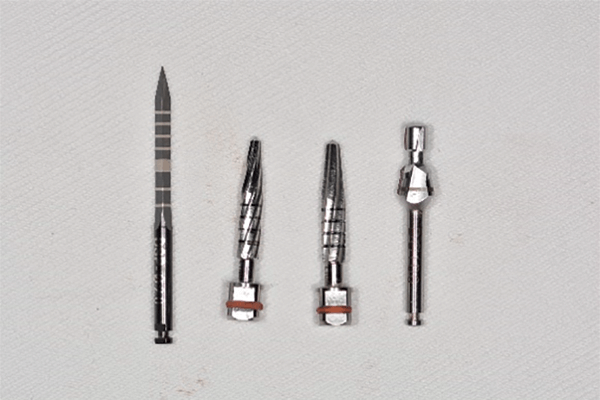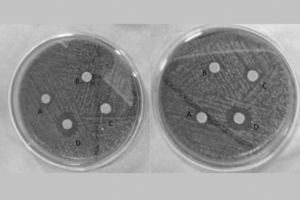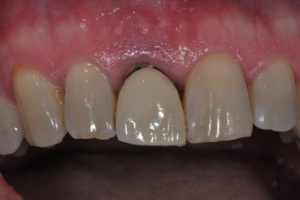RESUMO
Objetivo: avaliar, in vitro, a estabilidade inicial dos implantes instalados em ossos de baixa densidade (tipos III e IV), utilizando as técnicas de fresagem convencional, subfresagem, expansão óssea e osseodensificação. Material e métodos: para este estudo foram confeccionadas cavidades dimensionadas para o diâmetro dos implantes cônicos DSP (Campo Largo, Paraná, Brasil) em blocos de poliuretano em que foram inseridos 10 implantes para cada técnica de fresagem: convencional (CO) subfresagem (SB), expansão óssea (EO) e osseodensificação (OD) e em cada tipo ósseo (III e IV). A estabilidade inicial foi aferida com Osstell e os torques de inserção (TI) e remoção (TR) com auxílio de torquímetro analógico. Os resultados foram tabulados e comparados estatisticamente por meio dos testes Anova 2 fatores e Tukey, a correlação entre o TI, TR e a frequência de ressonância (ISQ) foi averiguada por testes de Person. Resultados: os maiores de TI e TR foi da técnica de expansão óssea em ambos os tipos ósseos, III, IV, (p< 0.05). Para frequência de ressonância, o valor de ISQ foi superior em todas as técnicas quando comparado à fresagem convencional (p< 0.05). O teste de Pearson demostrou correlação muito forte entre TI e TR (p< 0,001, r= 0,877) e forte entre TI e FR (p< 0,001, r= 0,830) e TR e ISQ (p< 0,001, r= 0,803). Conclusão: as técnicas de subfresagem, expansão óssea e osseodensificação apresentaram adequada estabilidade primária em ossos de baixa densidade (tipo III e IV) quando comparado à fresagem convencional.
Palavras-chave – Osseodensificação; Subfresagem; Expansão óssea.
ABSTRACT
Objective: to evaluate, in vitro, the initial stability of implants installed in low-density bone (types III and IV) using conventional drilling, under-drilling, bone expansion and osseodensification techniques. Material and methods: for this study, cavities sized to the diameter of DSP (Campo Largo, Paraná, Brazil) conical implants were made in polyurethane blocks into which 10 implants were inserted for each drilling technique, Conventional (CO) undermilling (SB), bone expansion (EO) and osseodensification (OD), and in each bone type (III and IV). The initial stability was measured with Osstell (RF), and the insertion (IT) and removal (RT) torques with the aid of a torque tester analogue. The results were tabulated and statistically compared using ANOVA 2-way and Tukey tests, and the correlation between the IT, RT, and the resonance frequency (RF) was ascertained by Pearson tests. Results: the highest IT and RT were from the bone expansion technique in both bone types (III, IV) (p < 0.05). For FR, the ISQ value was higher in all techniques when compared to conventional drilling (p < 0.05). Pearson’s test showed a very strong correlation between TI and TR (p < 0.001, r = 0.877) and a strong correlation between TI and FR (p < 0.001, r = 0.830) and TR and FR (p < 0.001, r = 0.803). Conclusion: the under-drilling, bone expansion and osseodensification techniques showed adequate primary stability in low-density bones (type III and IV) when compared to the conventional drilling technique, using insertion torque and resonance frequency as main references.
Key words – Osseodensification; Under-drilling; Bone expansion.
Referências
- Sargolzaie N, Samizade S, Arab H, Ghanbari H, Khodadadifard L, Khajavi A. The evaluation of implant stability measured by resonance frequency analysis in different bone types. J Korean Assoc Oral Maxillofac Surg 2019;45(1):29-33.
- Javed F, Ahmed HB, Crespi R, Romanos GE. Role of primary stability for successful osseointegration of dental implants: factors of influence and evaluation. Interv Med Appl Sci 2013;5(4):162-7.
- Martinez H, Davarpanah M, Missika P, Celletti R, Lazzara R. Optimal implant stabilization in low density bone. Clin Oral Implants Res 2001;12(5):423-32.
- Tabassum A, Meijer GJ, Walboomers XF, Jansen JA. Evaluation of primary and secondary stability of titanium implants using different surgical techniques. Clin Oral Implants Res 2014;25(4):487-92.
- Rocha FA, Elias CN. Influência da técnica cirúrgica e da forma do implante na estabilidade primária. Rev Odontol Bras Central 2010;18(48):26-9.
- Huwais S, Meyer EG. A novel osseous densification approach in implant osteotomy preparation to increase biomechanical primary stability, bone mineral density, and bone-to-implant contact. Int J Oral Maxillofac Implants 2017;32(1):27-36.
- Degidi M, Daprile G, Piattelli A. Influence of underpreparation on primary stability of implants inserted in poor quality bone sites: an in vitro study. J Oral Maxillofac Surg 2015;73(6):1084-8.
- El-Kholey KE, Elkomy A. Does the drilling technique for implant site preparation enhance implant success in low-density bone? A systematic review. Implant Dent 2019;28(5):500-9.
- Gayathri S. Osseodensification technique – a novel bone preservation method to enhance implant stability. Acta Scientific Dental Sciences 2018;2(12):17-22.
- Cortes AR, Cortes DN. Nontraumatic bone expansion for immediate dental implant placement: an analysis of 21 cases. Implant Dent 2010;19(2):92-7.
- Lee EA, Anitua E. Atraumatic ridge expansion and implant site preparation with motorized bone expanders. Pract Proced Aesthet Dent 2006;18(1):17-22.
- Huwais S. Enhancing implant stability with osseodensification – a case report with 2-year follow-up. Implant practice 2015;8(1):28-34.
- Pai UY, Rodrigues SJ, Talreja KS, Mundathaje M. Osseodensification – a novel approach in implant dentistry. J Indian Prosthodont Soc 2018;18(3):196-200.
- Trisi P, Berardini M, Falco A, Podaliri Vulpiani M. New osseodensification implant site preparation method to increase bone density in low-density bone: in vivo evaluation in sheep. Implant Dent 2016;25(1):24-31.
- Marković A, Calvo-Guirado JL, Lazić Z, Gómez-Moreno G, Ćalasan D, Guardia J et al. Evaluation of primary stability of self-tapping and non-self-tapping dental implants. A 12-week clinical study. Clin Implant Dent Relat Res 2013;15(3):341-9.
- Padhye NM, Padhye AM, Bhatavadekar NB. Osseodensification – a systematic review and qualitative analysis of published literature. J Oral Biol Craniofac Res 2020;10(1):375-80.
- Lages FS, Douglas-de Oliveira DW, Costa FO. Relationship between implant stability measurements obtained by insertion torque and resonance frequency analysis: a systematic review. Clin Implant Dent Relat Res 2018;20(1):26-33.
- Kahraman S, Bal BT, Asar NV, Turkyilmaz I, Tözüm TF. Clinical study on the insertion torque and wireless resonance frequency analysis in the assessment of torque capacity and stability of self-tapping dental implants. J Oral Rehabil 2009;36(10):755-61.
- Meredith N, Book K, Friberg B, Jemt T, Sennerby L. Resonance frequency measurements of implant stability in vivo. A cross-sectional and longitudinal study of resonance frequency measurements on implants in the edentulous and partially dentate maxilla. Clin Oral Implants Res 1997;8(3):226-33.
- Huwiler MA, Pjetursson BE, Bosshardt DD, Salvi GE, Lang NP. Resonance frequency analysis in relation to jawbone characteristics and during early healing of implant installation. Clin Oral Implants Res 2007;18(3):275-80.
- Hsu JT, Fuh LJ, Tu MG, Li YF, Chen KT, Huang HL. The effects of cortical bone thickness and trabecular bone strength on noninvasive measures of the implant primary stability using synthetic bone models. Clin Implant Dent Relat Res 2013;15(2):251-61.





